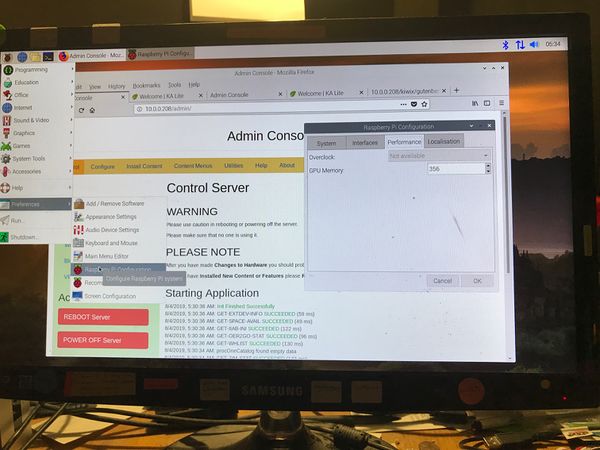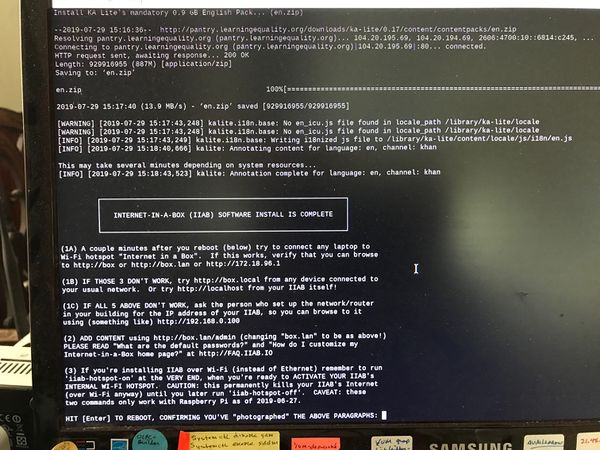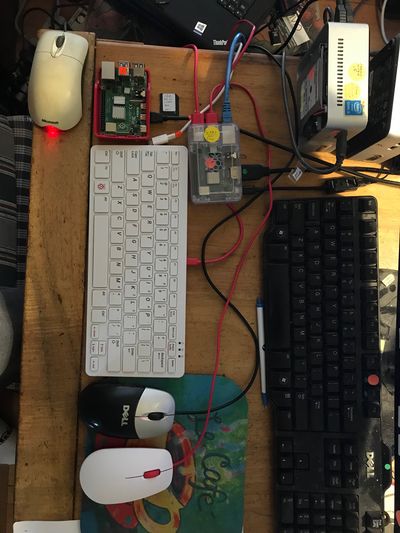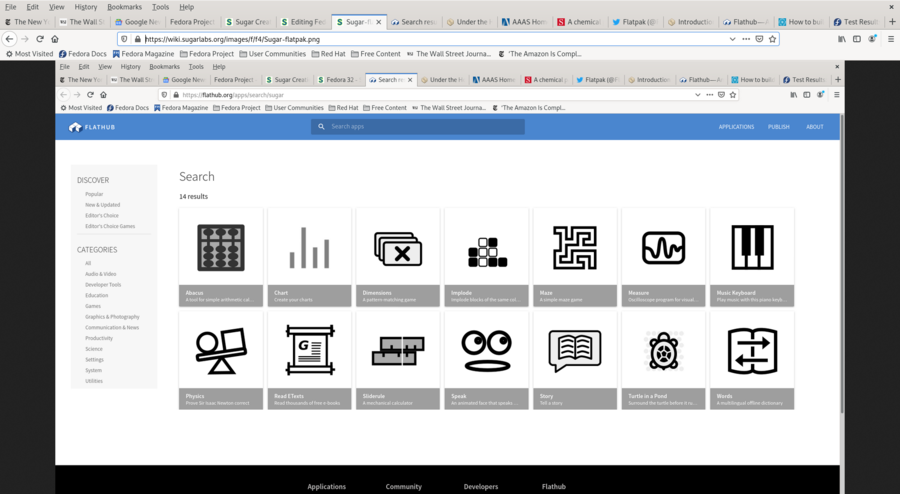Difference between revisions of "Fedora 32"
m (initial build of page) |
|||
| (94 intermediate revisions by 3 users not shown) | |||
| Line 4: | Line 4: | ||
; some of the older versions listed here ^ may be security risks- for archive purposes only | ; some of the older versions listed here ^ may be security risks- for archive purposes only | ||
=Fedora 32= | =Fedora 32= | ||
| − | ==Fedora 32 | + | |
| − | * updated | + | *https://fedoraproject.org/wiki/Releases/32/Spins#Official_Fedora_Spins |
| − | *https:// | + | |
| + | ==Fedora 32 Sugar on a Stick Beta== | ||
| + | *http://bit.ly/SoaS-F32-Beta-ISO | ||
| + | :https://fedoraproject.org/wiki/Test_Results:Fedora_32_Rawhide_20191119.n.2_Installation#How_to_test | ||
| + | * updated nov/23/2019 | ||
| + | ===Fedora Docs=== | ||
| + | ::https://docs.fedoraproject.org/en-US/docs/ | ||
| + | ===github.com/sugarlabs/=== | ||
| + | ::https://github.com/sugarlabs/ | ||
| + | |||
| + | ===NVIDIA=== | ||
| + | *https://rpmfusion.org/Howto/NVIDIA?highlight=Haxxa8CategoryHowtoHaxxa9 | ||
| + | ===rpmfusion=== | ||
| + | *https://rpmfusion.org/Configuration | ||
| + | |||
| + | ===Rpi=== | ||
| + | :Note there is no rpi4 support at this time | ||
| + | ====Raspberry_Pi==== | ||
| + | "Fedora supports the the Raspberry Pi Model 2B and 3-series of devices including the 3B, 3B+, 3A+, 3CM and 3CM+ in Fedora 29 and later releases." | ||
| + | * https://www.balena.io/etcher/ ( Used to flash micro-sd) | ||
| + | |||
| + | * https://fedoraproject.org/wiki/Architectures/ARM/Raspberry_Pi (read this first) | ||
| + | * https://dl.fedoraproject.org/pub/fedora/linux/development/32/Spins/armhfp/images/Fedora-SoaS-armhfp-32-20200322.n.0-sda.raw.xz | ||
| + | * https://www.tomshardware.com/reviews/raspberry-pi-command-line-commands,6159.html | ||
| + | * https://mirrors.rit.edu/fedora/fedora/linux/releases/29/Spins/armhfp/images/ | ||
| + | * https://fedoraproject.org/wiki/Architectures/ARM | ||
| + | * https://www.raspberrypi.org/documentation/hardware/raspberrypi/revision-codes/README.md (determining raspberrypi versions) | ||
| + | * https://github.com/sugarlabs/sugar/blob/master/docs/rpi-soas.md | ||
| + | ::https://wiki.sugarlabs.org/go/Sugar_Creation_Kit/sck/Advanced_Topics#Raspberry_Pi_.2F_RPi (old work) | ||
| + | ::https://wiki.cdot.senecacollege.ca/wiki/Raspberry_Pi_Fedora_Remix_Installation | ||
| + | ::https://www.raspberrypi.org/downloads/ | ||
| + | ::http://pidora.ca/ | ||
| + | ::https://elinux.org/RPi_Distributions#Fedora_Remix | ||
| + | ::https://fedoraproject.org/wiki/QA:Testcase_Virt_ARM_on_x86 (install arm in VMM) | ||
| + | |||
| + | =====Installation method used for testing===== | ||
| + | #Download Fedora-SoaS-armhfp..sda.raw.xz file to /Downloads | ||
| + | #extract here to expand to Fedora-SoaS-armhfp..sda.raw.xz file | ||
| + | #start Fedora Media Writer/select Fedora-SoaS-armhfp..sda.raw file in "Custom" | ||
| + | #insert micro SD into usb Card Reader and plug in it's USB | ||
| + | #select RPiB3+ and write Fedora-SoaS-armhfp..sda.raw.xz file | ||
| + | #exit Fedora MediaWriter | ||
| + | #start gparted and expand partition 3 to full size of micro SD (Class 10 32 GB) | ||
| + | #insert mico SD in RPi3B+ slot and power up. | ||
| + | |||
| + | ==Fedora MediaWriter== | ||
| + | *https://github.com/FedoraQt/MediaWriter/releases | ||
| + | *https://fedoraproject.org/wiki/Test_Day:2019-04-30_Fedora_Media_Writer | ||
| + | |||
| + | =Raspberry-Pi-IIAB= | ||
| + | *http://wiki.laptop.org/go/IIAB/FAQ | ||
| + | *https://en.wikipedia.org/wiki/Raspbian | ||
| + | *http://downloads.raspberrypi.org/raspbian/release_notes.txt | ||
| + | *https://www.raspberrypi.org/documentation/installation/installing-images/linux.md | ||
| + | ::https://www.youtube.com/channel/UC0cBGCxr_WPBPa3IqPVEe3g | ||
| + | *https://www.raspberrypi.org/downloads/raspbian/ | ||
| + | *https://github.com/iiab/iiab/wiki/Raspberry-Pi-IIAB-Images | ||
| + | *https://en.wikipedia.org/wiki/Raspberry_Pi#Third_party_application_software | ||
| + | *http://med.iiab.me/home/ (live medical iiAB sample) | ||
| + | ==Install of IIAB on RPi4== | ||
| + | "The Raspberry Pi 4 is the latest upgrade in the Raspberry Pi SBC series. : | ||
| + | This one has a Quadcore A72 CPU, up to 4 GB of LPDDR4 RAM, 2x USB 2.0, 2x USB 3.0 ports, double micro-HDMI ports, AC Wifi, Bluetooth 5.0 and Gigabit ethernet." | ||
| + | |||
| + | *;NOTE medium and full install include sugarizer-server (default) | ||
| + | ::https://sugarizer.org/ | ||
| + | ::https://github.com/llaske/sugarizer | ||
| + | ::https://github.com/llaske/sugarizer-server | ||
| + | ::Aug 6 2017 | ||
| + | *Same install on a 32GB sd: using my Rpi3B+. | ||
| + | *Only difference: used medium install and only downloaded a few items to test | ||
| + | |||
| + | --------- | ||
| + | ::Aug 2 2017 | ||
| + | :Installed "Raspbian Buster with desktop and recommended software" (1) | ||
| + | *https://downloads.raspberrypi.org/raspbian_full_latest (2019-07-10) | ||
| + | ::2019-07-10-raspbian-buster-full.img (extracted: 6.4 GB) | ||
| + | :::256 GB SanDisk Ultra micoSDXC A1 card | ||
| + | Install with Etcher: | ||
| + | *https://www.balena.io/etcher/ | ||
| + | ::In microSD reader | ||
| + | :::Insert card in RPi4 and power up: | ||
| + | |||
| + | *RPi4 (with 4 GB Memory) booted and changed GPU memory in "Preferences / Raspberry Pi4 Configuration" to [356] from [76] | ||
| + | |||
| + | ::( 2019-07-10-raspbian-buster-full - allows changing the allocated amount of memory in the RPi4) | ||
| + | :::(This appears to increase performance) | ||
| + | |||
| + | *https://github.com/raspberrypi/documentation/blob/master/configuration/raspi-config.md#memory-split | ||
| + | |||
| + | [[File:GPU_memory.jpg|600px]] | ||
| + | |||
| + | *in add/remove software: install firefox ESR | ||
| + | |||
| + | *in terminal: | ||
| + | curl d.iiab.io/install.txt | sudo bash | ||
| + | |||
| + | *chose maximum iiab install size | ||
| + | |||
| + | *used middle selection for type of install (single point) | ||
| + | |||
| + | *Start Ansible install | ||
| + | |||
| + | Photograph terminal screen when it shows: "Internet-In-A Box (IIAB) software install is complete" | ||
| + | |||
| + | [[File:IIAB-install.jpg|600px]] | ||
| + | |||
| + | ::Reboot (by hitting [enter] key) | ||
| + | |||
| + | *Change iiab-admin's password before connecting your server to the Internet. | ||
| + | You can do this within http://box.lan/admin -> Utilities menu — or at the command line, if you type "passwd iiab-admin". | ||
| + | |||
| + | *in firefox enter (in command line): 10.0.0.208/admin with user:iiab-admin and the password you entered above ^ | ||
| + | ::Starts Admin console | ||
| + | |||
| + | [[File:4%2B3B%2B.jpg|400px]] | ||
| + | |||
| + | *test setup ^ | ||
| + | |||
| + | (1) http://wiki.laptop.org/go/IIAB/FAQ#Is_a_quick_installation_possible.3F | ||
| + | ===NOTES=== | ||
| + | * run iiab-hotspot-on and iiab-hotspot-off which are found in /usr/bin — these are especially useful after you've used a Raspberry Pi's internal Wi-Fi to download IIAB and content. | ||
| + | * http://wiki.laptop.org/go/IIAB/FAQ#What_services_.28IIAB_apps.29_are_suggested_during_installation.3F | ||
| + | * https://nullr0ute.com/2016/09/connect-to-a-wireless-network-using-command-line-nmcli/ | ||
| + | |||
| + | =Internet of Things (iot)= | ||
| + | *https://iot.fedoraproject.org/ | ||
| + | *https://kojipkgs.fedoraproject.org/compose//iot/ | ||
| + | ::https://docs.fedoraproject.org/en-US/iot/ | ||
| + | ::https://iot.mozilla.org/gateway/ | ||
| + | ::https://medium.com/@suyoggunjal/windows-10-iot-core-on-raspberry-pi-3-8c9ea0861de6 (windows-10-iot-core-on-raspberry-pi-3) | ||
| + | |||
| + | |||
| + | |||
| + | |||
| + | |||
| + | |||
| + | |||
| + | |||
| + | |||
| + | |||
| + | =Atomic= | ||
| + | "CentOS Atomic Host is a lean operating system designed to run Docker containers, built from standard CentOS 7 RPMs, and tracking the component versions included in Red Hat Enterprise Linux Atomic Host. " | ||
| + | *https://wiki.centos.org/SpecialInterestGroup/Atomic/Download | ||
| + | ::https://lists.projectatomic.io/projectatomic-archives/atomic-devel/2018-June/msg00078.html | ||
| + | :::Merging into coreos | ||
| + | *https://infrastructure.fedoraproject.org/cgit/ansible.git/commit/?id=3bbae53 | ||
| + | :removing f29 target | ||
| + | |||
| + | =modularity= | ||
| + | *https://docs.pagure.org/modularity/ | ||
| + | |||
| + | =fedora-coreos= | ||
| + | ;Server (flatpacks) | ||
| + | "CoreOS, a new Fedora edition built specifically for running containerized workloads securely and at scale." | ||
| + | *https://fedoramagazine.org/introducing-fedora-coreos/ | ||
| + | ::https://github.com/coreos/fedora-coreos-docs/ | ||
| + | ::https://github.com/openshift/okd/blob/master/README.md | ||
| + | |||
| + | =Silverblue= | ||
| + | ;Workstation (flatpacks) | ||
| + | *https://silverblue.fedoraproject.org/ | ||
| + | *https://docs.fedoraproject.org/en-US/fedora-silverblue/toolbox/ | ||
| + | *https://docs.fedoraproject.org/en-US/fedora-silverblue/ | ||
| + | ::https://docs.fedoraproject.org/en-US/fedora-silverblue/toolbox/ | ||
| + | :still in development | ||
| + | "Fedora Silverblue is an immutable desktop operating system, which aims to be extremely stable and reliable. It also aims to be an excellent platform for developers and for those using container-focused workflows." | ||
| + | =flatpaks= | ||
| + | ::"A universal packaging format with a decentralized means of distribution. Plus, portability and sandboxing." | ||
| + | :;Many soas (sugar) apps are being converted to flatpacks which install into f32 #silverblue and f31 workstation. | ||
| + | ::this may be the future for sugar | ||
| + | ::https://flathub.org/apps/search/sugar | ||
| + | [[File:Sugar-flatpak-2.png|900px]] | ||
| + | ;Also works with CentOS-7-x86_64-LiveGNOME-1908.iso after update 2019/12/30 | ||
| + | :Reported: works with KDE and endlessOS 2020/01/03 | ||
| + | *https://flatpak.readthedocs.io/en/latest/under-the-hood.html How it works | ||
| + | *http://docs.flatpak.org/en/latest/ | ||
| + | *http://docs.flatpak.org/en/latest/first-build.html | ||
| + | ::https://flatpak.org/setup/Fedora/ | ||
| + | ::https://developers.redhat.com/blog/2019/04/24/how-to-run-systemd-in-a-container/ | ||
| + | ::https://github.com/containers/libpod/ | ||
| + | ::https://flathub.org/apps/collection/recently-updated | ||
| + | ::https://flatpak.readthedocs.io/en/latest/under-the-hood.html | ||
| + | ::https://firefox-flatpak.mojefedora.cz/ | ||
| + | ::http://docs.flatpak.org/en/latest/sandbox-permissions.html | ||
| + | :::https://flathub.org/repo/appstream/org.fedoraproject.MediaWriter.flatpakref | ||
| + | |||
| + | |||
| + | *https://github.com/tchx84/sugarapp/blob/master/flatpak-guide-common-issues.md | ||
| + | *https://twitter.com/@FlatpakApps | ||
| + | ::https://opensource.com/article/19/10/how-build-flatpak-packaging?sc_cid=70160000001273HAAQ | ||
| + | *https://flathub.org/home | ||
| + | ::"Welcome to Flathub, the home of hundreds of apps which can be easily installed on any Linux distribution. Browse the apps online, from your app center or the command line. " | ||
| + | |||
| + | =Endless OS= | ||
| + | *https://endlessos.com/download/ (eos-eos3.6-amd64-amd64.190709-170830.en.iso torrent only - free) | ||
| + | :"Endless OS is a free, easy-to-use operating system preloaded with over 100 apps.." (32GB installer usb - uses flatpacks) | ||
| + | ::https://betanews.com/2019/06/12/debian-10-buster-endless-os-linux/ | ||
| + | :::https://github.com/endlessm (github) | ||
| + | :::https://firefox-flatpak.mojefedora.cz/ (firefox flatpack that installs) | ||
| + | :::"This is an unofficial Firefox flatpak repository provided by Fedora and Red Hat maintainers and made for testing purposes. " | ||
| + | :::https://github.com/flathub/org.fedoraproject.MediaWriter/issues/5 (Fedora MediaWriter bug in flatpack) | ||
| + | ::::"Endless OS is built on top of decades of efforts from the free and open-source software community, and we acknowledge a great debt to it. We contribute back to open source projects whenever we can, but not all the software shipped on our computer is open source. Please refer to https://endlessm.com/for-developers developer for more information." | ||
| + | |||
| + | ==references== | ||
| + | *http://wiki.laptop.org/go/The_OLPC_Wiki | ||
| + | *http://linuxcommand.org/lc3_lts0090.php | ||
| + | *https://www.redhat.com/en/blog/transforming-development-experience-within-centos | ||
| + | :https://developers.redhat.com/blog/2019/09/24/changes-to-centos-what-centos-stream-means-for-developers/ | ||
| + | :https://fedoraproject.org/wiki/QA:Testcase_Virt_ARM_on_x8 | ||
| + | :https://npmccallum.gitlab.io/post/cross-architecture-roots-with-dnf/ | ||
| + | :https://fedoraproject.org/wiki/QA:Updates_Testing | ||
| + | ===GCI=== | ||
| + | *https://opensource.googleblog.com/2019/09/google-code-in-2019-is-right-around_23.html | ||
| + | ::https://codein.withgoogle.com/ | ||
| + | **https://wiki.sugarlabs.org/go/Google_Code_In_2019 | ||
| + | ===Quickstart=== | ||
| + | *https://wiki.sugarlabs.org/go/Development_Team/Quickstart | ||
| + | |||
| + | ===olpc=== | ||
| + | *https://ktpress.rw/2019/11/from-olpc-xo-to-positivo-rwanda-sets-the-bar-higher/ | ||
| + | "Thanks Samson. | ||
| + | |||
| + | For Sugar Labs, the most important part is "the machines will have the | ||
| + | same modules (interface) for children lesson," so there's an | ||
| + | opportunity for Sugar Labs to remain involved. | ||
| + | |||
| + | I don't know what operating system REB are using, but OLPC OS 18.04.0 | ||
| + | based on Ubuntu 18.04.2 and Sugar will likely work straight away on | ||
| + | PC-compatible laptops, and can be customised and rebuilt. Our OLPC | ||
| + | servers do see update requests from countries were we have not | ||
| + | distributed our PC-compatible laptops, which is cool." | ||
| + | |||
| + | James Cameron | ||
| + | |||
| + | *https://codein.withgoogle.com/archive/2017/organization/5747080974827520/task/5319990500655104/ | ||
| + | ::https://wiki.sugarlabs.org/go/Live_Build | ||
| + | ::https://github.com/walterbender/sugar-live-build | ||
Latest revision as of 10:40, 22 March 2020
 Fedora® version page: 17 | 18 | 19 | 20 | 21 | 22 | 23 | 24 | 25 | 26 | 27 | 28 | 29 | 30 | 31 | 32 |
Fedora® version page: 17 | 18 | 19 | 20 | 21 | 22 | 23 | 24 | 25 | 26 | 27 | 28 | 29 | 30 | 31 | 32 |
Fedora and the Infinity design logo are trademarks of Red Hat, Inc.
- some of the older versions listed here ^ may be security risks- for archive purposes only
Fedora 32
Fedora 32 Sugar on a Stick Beta
- updated nov/23/2019
Fedora Docs
github.com/sugarlabs/
NVIDIA
rpmfusion
Rpi
- Note there is no rpi4 support at this time
Raspberry_Pi
"Fedora supports the the Raspberry Pi Model 2B and 3-series of devices including the 3B, 3B+, 3A+, 3CM and 3CM+ in Fedora 29 and later releases."
- https://www.balena.io/etcher/ ( Used to flash micro-sd)
- https://fedoraproject.org/wiki/Architectures/ARM/Raspberry_Pi (read this first)
- https://dl.fedoraproject.org/pub/fedora/linux/development/32/Spins/armhfp/images/Fedora-SoaS-armhfp-32-20200322.n.0-sda.raw.xz
- https://www.tomshardware.com/reviews/raspberry-pi-command-line-commands,6159.html
- https://mirrors.rit.edu/fedora/fedora/linux/releases/29/Spins/armhfp/images/
- https://fedoraproject.org/wiki/Architectures/ARM
- https://www.raspberrypi.org/documentation/hardware/raspberrypi/revision-codes/README.md (determining raspberrypi versions)
- https://github.com/sugarlabs/sugar/blob/master/docs/rpi-soas.md
- https://wiki.sugarlabs.org/go/Sugar_Creation_Kit/sck/Advanced_Topics#Raspberry_Pi_.2F_RPi (old work)
- https://wiki.cdot.senecacollege.ca/wiki/Raspberry_Pi_Fedora_Remix_Installation
- https://www.raspberrypi.org/downloads/
- http://pidora.ca/
- https://elinux.org/RPi_Distributions#Fedora_Remix
- https://fedoraproject.org/wiki/QA:Testcase_Virt_ARM_on_x86 (install arm in VMM)
Installation method used for testing
- Download Fedora-SoaS-armhfp..sda.raw.xz file to /Downloads
- extract here to expand to Fedora-SoaS-armhfp..sda.raw.xz file
- start Fedora Media Writer/select Fedora-SoaS-armhfp..sda.raw file in "Custom"
- insert micro SD into usb Card Reader and plug in it's USB
- select RPiB3+ and write Fedora-SoaS-armhfp..sda.raw.xz file
- exit Fedora MediaWriter
- start gparted and expand partition 3 to full size of micro SD (Class 10 32 GB)
- insert mico SD in RPi3B+ slot and power up.
Fedora MediaWriter
- https://github.com/FedoraQt/MediaWriter/releases
- https://fedoraproject.org/wiki/Test_Day:2019-04-30_Fedora_Media_Writer
Raspberry-Pi-IIAB
- http://wiki.laptop.org/go/IIAB/FAQ
- https://en.wikipedia.org/wiki/Raspbian
- http://downloads.raspberrypi.org/raspbian/release_notes.txt
- https://www.raspberrypi.org/documentation/installation/installing-images/linux.md
- https://www.raspberrypi.org/downloads/raspbian/
- https://github.com/iiab/iiab/wiki/Raspberry-Pi-IIAB-Images
- https://en.wikipedia.org/wiki/Raspberry_Pi#Third_party_application_software
- http://med.iiab.me/home/ (live medical iiAB sample)
Install of IIAB on RPi4
"The Raspberry Pi 4 is the latest upgrade in the Raspberry Pi SBC series. : This one has a Quadcore A72 CPU, up to 4 GB of LPDDR4 RAM, 2x USB 2.0, 2x USB 3.0 ports, double micro-HDMI ports, AC Wifi, Bluetooth 5.0 and Gigabit ethernet."
- NOTE medium and full install include sugarizer-server (default)
- Same install on a 32GB sd: using my Rpi3B+.
- Only difference: used medium install and only downloaded a few items to test
- Aug 2 2017
- Installed "Raspbian Buster with desktop and recommended software" (1)
- 2019-07-10-raspbian-buster-full.img (extracted: 6.4 GB)
- 256 GB SanDisk Ultra micoSDXC A1 card
- 2019-07-10-raspbian-buster-full.img (extracted: 6.4 GB)
Install with Etcher:
- In microSD reader
- Insert card in RPi4 and power up:
- In microSD reader
- RPi4 (with 4 GB Memory) booted and changed GPU memory in "Preferences / Raspberry Pi4 Configuration" to [356] from [76]
- ( 2019-07-10-raspbian-buster-full - allows changing the allocated amount of memory in the RPi4)
- (This appears to increase performance)
- ( 2019-07-10-raspbian-buster-full - allows changing the allocated amount of memory in the RPi4)
- in add/remove software: install firefox ESR
- in terminal:
curl d.iiab.io/install.txt | sudo bash
- chose maximum iiab install size
- used middle selection for type of install (single point)
- Start Ansible install
Photograph terminal screen when it shows: "Internet-In-A Box (IIAB) software install is complete"
- Reboot (by hitting [enter] key)
- Change iiab-admin's password before connecting your server to the Internet.
You can do this within http://box.lan/admin -> Utilities menu — or at the command line, if you type "passwd iiab-admin".
- in firefox enter (in command line): 10.0.0.208/admin with user:iiab-admin and the password you entered above ^
- Starts Admin console
- test setup ^
(1) http://wiki.laptop.org/go/IIAB/FAQ#Is_a_quick_installation_possible.3F
NOTES
- run iiab-hotspot-on and iiab-hotspot-off which are found in /usr/bin — these are especially useful after you've used a Raspberry Pi's internal Wi-Fi to download IIAB and content.
- http://wiki.laptop.org/go/IIAB/FAQ#What_services_.28IIAB_apps.29_are_suggested_during_installation.3F
- https://nullr0ute.com/2016/09/connect-to-a-wireless-network-using-command-line-nmcli/
Internet of Things (iot)
- https://docs.fedoraproject.org/en-US/iot/
- https://iot.mozilla.org/gateway/
- https://medium.com/@suyoggunjal/windows-10-iot-core-on-raspberry-pi-3-8c9ea0861de6 (windows-10-iot-core-on-raspberry-pi-3)
Atomic
"CentOS Atomic Host is a lean operating system designed to run Docker containers, built from standard CentOS 7 RPMs, and tracking the component versions included in Red Hat Enterprise Linux Atomic Host. "
- removing f29 target
modularity
fedora-coreos
- Server (flatpacks)
"CoreOS, a new Fedora edition built specifically for running containerized workloads securely and at scale."
Silverblue
- Workstation (flatpacks)
- https://silverblue.fedoraproject.org/
- https://docs.fedoraproject.org/en-US/fedora-silverblue/toolbox/
- https://docs.fedoraproject.org/en-US/fedora-silverblue/
- still in development
"Fedora Silverblue is an immutable desktop operating system, which aims to be extremely stable and reliable. It also aims to be an excellent platform for developers and for those using container-focused workflows."
flatpaks
- "A universal packaging format with a decentralized means of distribution. Plus, portability and sandboxing."
- Many soas (sugar) apps are being converted to flatpacks which install into f32 #silverblue and f31 workstation.
- this may be the future for sugar
- https://flathub.org/apps/search/sugar
- Also works with CentOS-7-x86_64-LiveGNOME-1908.iso after update 2019/12/30
- Reported: works with KDE and endlessOS 2020/01/03
- https://flatpak.readthedocs.io/en/latest/under-the-hood.html How it works
- http://docs.flatpak.org/en/latest/
- http://docs.flatpak.org/en/latest/first-build.html
- https://flatpak.org/setup/Fedora/
- https://developers.redhat.com/blog/2019/04/24/how-to-run-systemd-in-a-container/
- https://github.com/containers/libpod/
- https://flathub.org/apps/collection/recently-updated
- https://flatpak.readthedocs.io/en/latest/under-the-hood.html
- https://firefox-flatpak.mojefedora.cz/
- http://docs.flatpak.org/en/latest/sandbox-permissions.html
- https://github.com/tchx84/sugarapp/blob/master/flatpak-guide-common-issues.md
- https://twitter.com/@FlatpakApps
- "Welcome to Flathub, the home of hundreds of apps which can be easily installed on any Linux distribution. Browse the apps online, from your app center or the command line. "
Endless OS
- https://endlessos.com/download/ (eos-eos3.6-amd64-amd64.190709-170830.en.iso torrent only - free)
- "Endless OS is a free, easy-to-use operating system preloaded with over 100 apps.." (32GB installer usb - uses flatpacks)
- https://betanews.com/2019/06/12/debian-10-buster-endless-os-linux/
- https://github.com/endlessm (github)
- https://firefox-flatpak.mojefedora.cz/ (firefox flatpack that installs)
- "This is an unofficial Firefox flatpak repository provided by Fedora and Red Hat maintainers and made for testing purposes. "
- https://github.com/flathub/org.fedoraproject.MediaWriter/issues/5 (Fedora MediaWriter bug in flatpack)
- "Endless OS is built on top of decades of efforts from the free and open-source software community, and we acknowledge a great debt to it. We contribute back to open source projects whenever we can, but not all the software shipped on our computer is open source. Please refer to https://endlessm.com/for-developers developer for more information."
- https://betanews.com/2019/06/12/debian-10-buster-endless-os-linux/
references
- http://wiki.laptop.org/go/The_OLPC_Wiki
- http://linuxcommand.org/lc3_lts0090.php
- https://www.redhat.com/en/blog/transforming-development-experience-within-centos
- https://developers.redhat.com/blog/2019/09/24/changes-to-centos-what-centos-stream-means-for-developers/
- https://fedoraproject.org/wiki/QA:Testcase_Virt_ARM_on_x8
- https://npmccallum.gitlab.io/post/cross-architecture-roots-with-dnf/
- https://fedoraproject.org/wiki/QA:Updates_Testing
GCI
Quickstart
olpc
"Thanks Samson.
For Sugar Labs, the most important part is "the machines will have the same modules (interface) for children lesson," so there's an opportunity for Sugar Labs to remain involved.
I don't know what operating system REB are using, but OLPC OS 18.04.0 based on Ubuntu 18.04.2 and Sugar will likely work straight away on PC-compatible laptops, and can be customised and rebuilt. Our OLPC servers do see update requests from countries were we have not distributed our PC-compatible laptops, which is cool."
James Cameron



